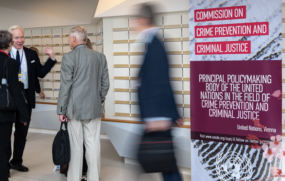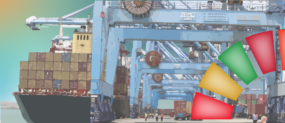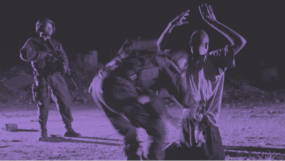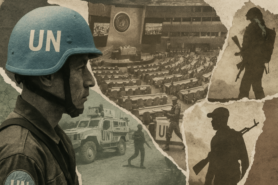Posted on 26 Jul 2019
Is the UN Security Council widening its approach to dealing with the links between terrorism and organized crime, or merely synthesizing existing efforts?
On 19 July 2019, the UN Security Council (UNSC) adopted its latest resolution (2482 (2019)) on the linkages between terrorism and organized crime. This is a topic that has been debated regularly in the UNSC since the first resolution, a month after 9/11, that recognized a ‘close connection between international terrorism and transnational organized crime, illicit drugs, money-laundering, illegal arms-trafficking, and illegal movement of nuclear, chemical, biological and other potentially deadly materials’. That resolution, 1373 (2001), called for national, regional and international cooperation to combat terrorism financing and money laundering.
The resolution, which has set the tone for all subsequent policy debates relating to the interconnections between terrorism and organized crime, was underpinned by the assumption that the primary strategic relationship between criminal and terrorist groups is financial.
Subsequent resolutions on the links between criminal and terrorist networks have become more expansive, highlighting the tactical and operational intersections between terrorism, criminal groups and illicit markets. For example, Resolution 2195 (2014) called upon states to examine and address the dual threats posed by organized crime and terrorism to security and development, while Resolution 2322 (2016) called for greater inter-governmental cooperation in preventing and prosecuting the operational transactions between political militants and career criminals.
Yet the weight of the discussion and, more importantly, the investment clout needed to scythe that intersection, have focused on terrorist financing.
What is now becoming increasingly apparent, however, is that the international community may be investing in tools that do not suit the crime. Resolution 2642 (2019) noted that terrorists have adopted various fund-raising tools closely connected with those of organized crime, including kidnapping and extortion; it called upon states to observe and replicate Financial Action Task Force (FATF) standards of financial-intelligence gathering. However, the FATF focuses its tools and instruments almost exclusively on the formal banking system and international transactions, whereas the methods of terrorist financing that Resolution 2642 describes fall outside of its jurisdictive purview.
This latest resolution builds on recent UNSC developments, including the March 2019 Resolution 2462, which addresses terrorism financing, and a July 2019 open debate at the UNSC on the organized crime–terrorism linkages, as well as the UNSC’s record of exploring these connections on its agenda going further back in time. Yet the new resolution is particularly noteworthy for its expansive coverage of organized crime, and the Council’s shift away from its focus on transnational crime to both transnational and domestic organized crime in relation to terrorism.
The resolution adopts the phrase ‘organized crime, whether domestic or transnational’ throughout, which allows the UNSC, and specifically its terrorism branch, more room to manoeuvre in domestic settings. It is interesting that the UNSC would grant such leeway, since at the international level, states continue to disagree over the appropriate regimes for addressing crime versus terrorism, and over where policy spaces should overlap. In fact, Council members were not able to settle on a way to define this relationship and the paragraph was scrapped. Russia, in particular, cautioned against states using it for political purposes at the adoption of the resolution. In part, the resolution is responding to some states’ concerns over their domestic issues, such as radicalization in prisons and the return of foreign fighters. Others will resist potential mission creep of the terrorism agenda into efforts focused on criminal justice.
While the new resolution captures elements from a number of earlier resolutions – for instance, on terrorism financing; youth; peace and security; and foreign terrorist fighters – it reads more forcefully as a call to arms to fight crime than it does to address terrorism. It goes into levels of specificity on crimes that seem outside the terrorism linkage discussion. For instance, the resolution highlights drug traffickers’ use of modern commerce to traffic in precursors, pre-precursor chemicals and synthetic drugs, and their use of online markets to sell synthetic drugs, in particular synthetic opioids. Thistype of activitymay well have a link to terrorism, yet the language is couched in a way that makes it read more like a resolution from the UN’s Commission on Narcotic Drugs. It encourages increased domestic prosecution of human trafficking, and details states’ responsibilities to prevent the illicit manufacture of and trade in various categories of weapons, from small arms and light weapons to explosives and military equipment. On criminal-justice systems, it draws a thread from engagement in petty crimes to involvement in terrorism, encourages safe and humane prison settings, and urges steps be taken to prevent radicalization in prison environments.
How this resolution will impact policy implementation is another question.
One area that has continued to receive little attention in this resolution (or the March 2019 resolution) is the use of extortion and taxation as an area where the phenomena of terrorism and organized crime overlap. The July resolution contains one reference to good governance, in relation to combating money laundering, and one reference to extortion as a financing source. While governance and extortion are recognized issues, they are not a focus.
This would seem a critical oversight. Research conducted by the Global Initiative, INTERPOL and RHIPTO, the Norwegian Centre for Global Analysis, showed that one of the largest and most pervasive forms of financing for terrorist and non-state armed groups was extortion, making up 17 per cent of their total income. This includes the levying of protection taxes over both legitimate and illicit trade, including the trafficking of environmental commodities, arms flows, and people smuggling and trafficking.
In many cases, the intersection between terrorism and organized crime exists in areas that lack state governance structures, and these forms of financing not only generate income, but also project an image of legitimate rule. At its height, the Islamic State was estimated to have generated over US$6 billion, predominantly from extorting taxes and tariffs from local populations under the threat of violence. Al-Shabaab in Somalia is estimated to have collected US$27 million in 2017, just from extorting businesses and blockading trade routes. Through the use of mafia-based extortion strategies, terrorist organizations and criminal groups alike leverage the tools of violence, illicit economy and political ideology to achieve social, financial or political ends.
The July resolution calls for research to develop a better understanding of the nature and scope of the linkages; it requests the Secretary-General to submit a report by the UN Office of Counter-Terrorism and the UN Office on Drugs and Crime on the linkages between terrorism and organized crime, ‘whether transnational or domestic’, in a year’s time. It also encourages member states to engage local communities and non-governmental actors to address these issues.
From our experience at the Global Initiative, in seeking to address contemporary manifestations of the organized crime and terror nexus, there are critical lessons to be learned from responses to extortion and governance by violence enacted by criminal groups.
Extortion and protection are quintessential mafia activities, used by territorial criminal groups the world over. Research by the Global Initiative on extortion in all five continents has shown that while security- and justice-led strategies are common, they are rarely effective unless reinforced by a unified response from the communities most affected. Coalitions made up of civil society, business and local authorities are needed to reduce the potency of violent protection economies.
As the Security Council and the UN continue to advance their understanding of the linkages between terrorism and organized crime, extortion and forms of criminal governance are both a critical area for research and an area where there are transferrable lessons from combating organized crime that can perhaps help in countering terrorism.



